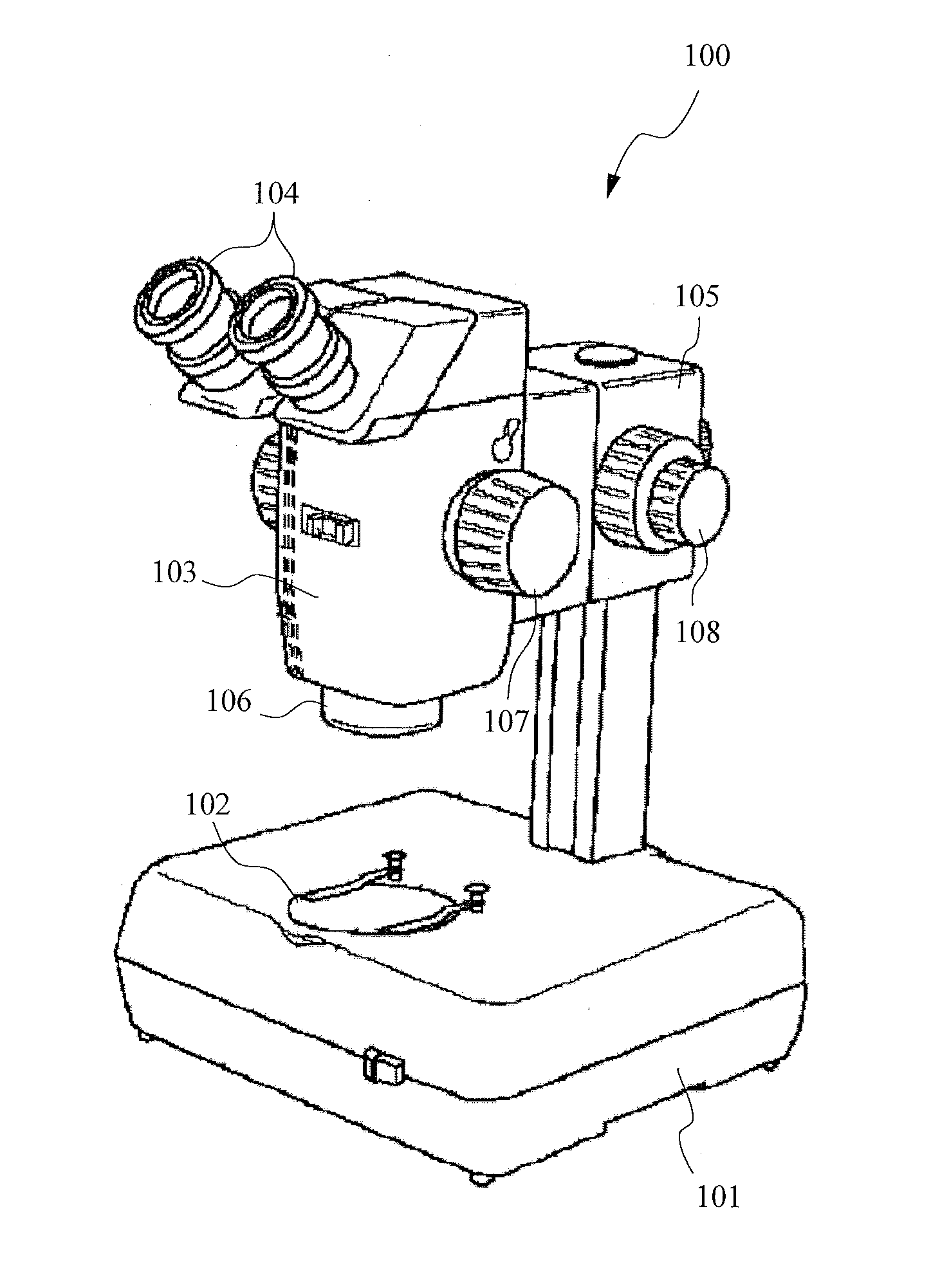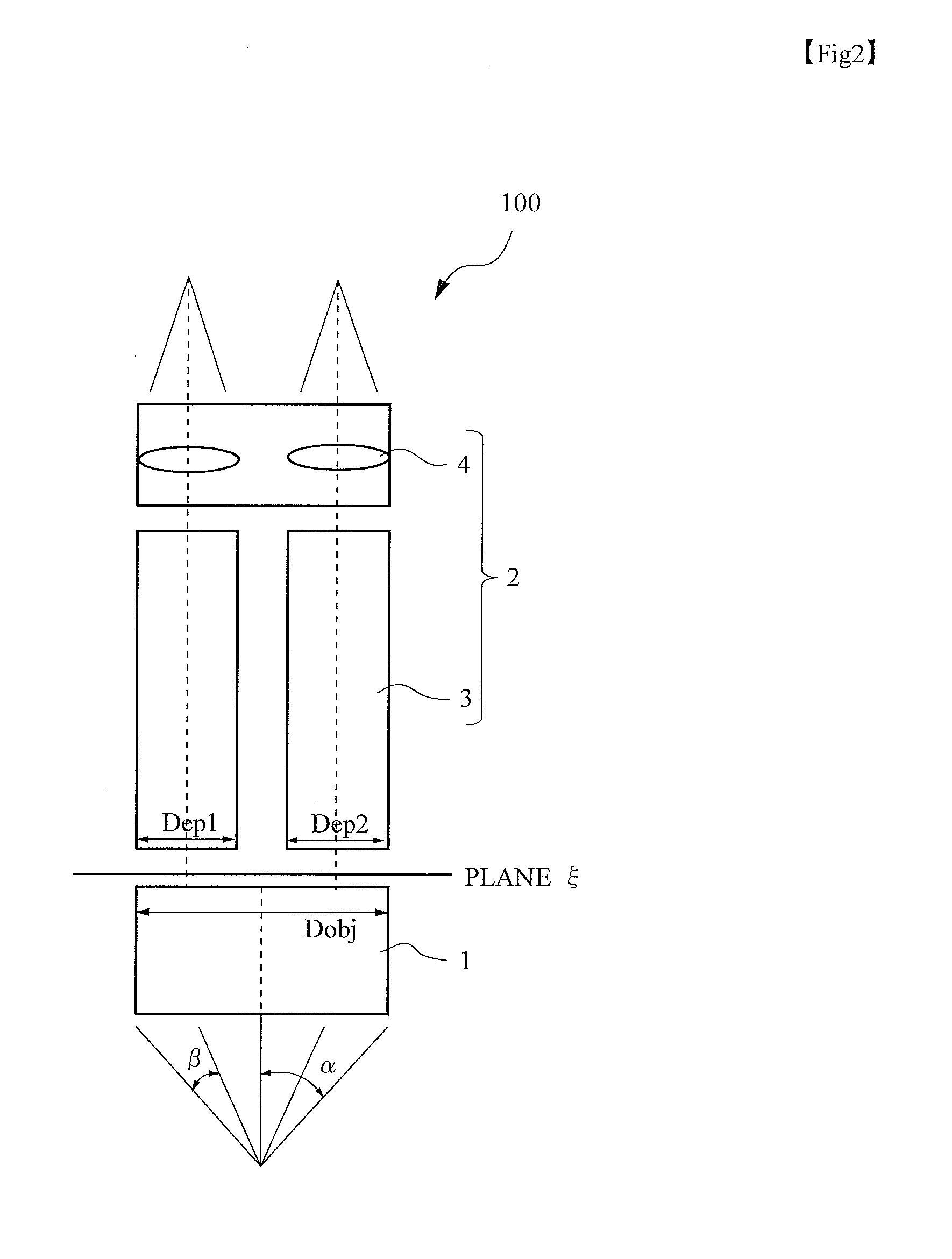Microscope apparatus
a technology of microscope and microscope, applied in the field of microscope equipment, can solve the problems of reducing the resolution power, and reducing the optical performance of the objective lens
- Summary
- Abstract
- Description
- Claims
- Application Information
AI Technical Summary
Benefits of technology
Problems solved by technology
Method used
Image
Examples
first embodiment
[0031]Hereinafter, preferred embodiments of the present invention will be described with reference to the drawings. In a first embodiment, a case of dividing light exited from an objective lens into two optical paths will be described. First, a configuration of a parallel stereoscopic microscope will be described using FIG. 1. A parallel stereoscopic microscope 100 is a microscope apparatus with a single-objective binocular configuration and includes: a base unit (illumination unit) 101 including a transmitted illumination apparatus; a variable power lens barrel 103 provided with an objective lens and an eyepiece and including variable power lens groups (variable power optical systems) inside; and a focusing apparatus 105. A sample platform 102 embedded with a transparent member is provided on the upper surface of the base unit 101. The objective lens is attached to an objective lens attachment unit 106 provided below the variable power lens barrel 103. In the objective lens attachm...
modified example 1 of first embodiment
[0045]Although a case of symmetrically arranging the two observation optical systems 2 (variable power lens groups 3) in the X-axis direction of FIG. 4A relative to the optical axis of the objective lens 1 has been described in the above description, the entire variable power lens barrel 103 can be moved relative to the optical axis so that the axial luminous flux diameter Dobj of the objective lens 1 completely includes the entrance pupil of one of the two observation optical systems 2 as shown in FIG. 6 to increase the numerical aperture of at least the optical path of one side compared to the numerical aperture of the conventional parallel stereoscopic microscope apparatus in which the numerical aperture is limited to the distance between the optical axes. Particularly, if the axial luminous flux diameter Dobj of the objective lens 1 is designed to be able to include any one of the entrance pupils of the left and right optical paths (entrance pupil indicated by Dept or entrance p...
modified example 2 of first embodiment
[0046]In recent years, demand for a stereoscopic microscope apparatus capable of observing a wide variable power range by one apparatus is increasing along with the diversification of applications. Particularly, there is a strong demand for the enlargement to the low-power range that allows viewing the entire image of a small animal or the like. FIG. 7 shows optical path diagrams of the objective lens 1 and the variable power lens group 3 of one side, and configurations in which the variable power lens group 3 in two different states of magnification is set to the same objective lens 1 are arranged above and below. FIG. 7(a) shows a low-power end state, and FIG. 7(b) shows a high-power end state. As is clear from FIG. 7, the position of the ray passing through the objective lens 1 is totally different during low-power and during high-power of the variable power lens group 3.
[0047]The magnification of the observation optical system 2 can be calculated by dividing a value f zoom, whic...
PUM
 Login to View More
Login to View More Abstract
Description
Claims
Application Information
 Login to View More
Login to View More - R&D
- Intellectual Property
- Life Sciences
- Materials
- Tech Scout
- Unparalleled Data Quality
- Higher Quality Content
- 60% Fewer Hallucinations
Browse by: Latest US Patents, China's latest patents, Technical Efficacy Thesaurus, Application Domain, Technology Topic, Popular Technical Reports.
© 2025 PatSnap. All rights reserved.Legal|Privacy policy|Modern Slavery Act Transparency Statement|Sitemap|About US| Contact US: help@patsnap.com



